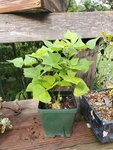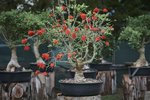Hi Joe
I see the guys have answered your question and they are 100% spot on with the identification of the species as Erythrina (Otherwise known as the common Coral Tree)
They are fantastic species to work with as bonsai and grow very easily from large cuttings.
I have a thread on BNut (Which I haven't updated for about 2 years but will do now this weekend) should you want to check it out.
Common Coral Tree
This is a quick pic of what it looks like this morning.
View attachment 325404
Coral Trees have the most amazing orange red flowers but are very difficult to attain on bonsai as they only flower on previous years growth which makes your tree look long and leggy with no current style. This is not my tree but one I found on the internet to give you an idea of what I mean. Many people let it grow out for a season or 2 to get it to flower to see what it looks like and then cut it back into style.
View attachment 325401
This one below is unfortunately been photoshopped as you can see so many of the flowers are exactly the same and there is no ways they flower on such short branches.
View attachment 325402
They love to be in full sun and prefer to keep on the dryer side. The pot very easily into shallow pots. One of mine is in a pot with a depth of about 1-2 cm's and it has no problems. During the winter times, watering is reduced to 1 times every 1-2 weeks.
As you will notice the leaves are in 3 leaflets and the general consensus is to always cut away the middle one and leave the left and right leaves. The earlier you can do that, the better as it does to some extent help with leaf reduction. Leaf reduction is difficult but I found that the more sun it gets and the continual cutting away of leaves over a period does help on this too. Bear in mind though, you will probably never get very small leaves so the bigger you grow the tree the better it will look in leaf.
Do not hesitate to give me a shout if you need any more information and I will gladly assist.












